The Florence Tour
Now, on with the show. First, our hotel was opposite the Church of Santa Maria Novelle (A in the map below). The hotel was very nice, but not particularly photogenic and I never took a picture of it.
Saturday morning, the 9th, we had a "Walking Tour of Florence and the David statue at the Accademia". It was quite a walk. But Florence is a compact city and it is very walkable. We met at the Piazza della Repubblica (B), which marked the north/south and east/west crossroads of the original Roman city.
The column marks where the two roads intersected.
We next walked to the Ponte Vecchio (C). Our guide explained the second-story passageway built for Cosimo I to pass from his Palazzo Pitti all the way to the Palazzo Vecchio. More pictures later.
A view of the Ponte Vecchio from the Uffizi Gallery. The red tile roof is the enclosed gallery that Duke Cosimo I had built between the Palazzo Vecchio and the Palazzo Pitti.
As we walked to the Uffizi galleries, we passed a memorial to a 1993 Cosa Nostra vendetta bombing in which a family of four and one other were killed in a car bomb (D). A 250-year-old olive tree was planted at the site in 2004. Recently, a bronze memorial has replaced the tree. Five capo members of the Cosa Nostra family were convicted to life imprisonment in 2004. The last person convicted of the bomb was located this past year and was imprisoned for life this year.

.
We next entered plaza of the Uffizi gallery (E). One of the best known art museums in the world, it is housed in the "the offices" of Cosimo I's rule.

Leonardo di Vinci in one of the archways on
the first floor of the gallery. Much more on Tuesday.
You walk right in to the Piazzo della Signoria (F) and the Palazzo Vecchio, Duke Cosimo I's confiscated house before he purchased the Palazza Pitti. Michelangelo's David was here for 370 years out and exposed before it was taken to the Accademia.
The Loggia del Lanzi is just to the right in the arched gallery. It was a originally a forum for public debate, but it was converted to a sculpture garden when when public debate was "inconvenient."
Benvenute Cellini's Perseus The Rape of the Sabine Women
The house of Dante Alligari.
And up the block is the church where Dante first saw Beatrice. He said he fell in love with her at first glance. Because of that, lovers leave notes and locks to show their undying love for each other.
.jpeg)
It is a very small church, tucked into the middle of the block. As compared to....
The Cattedrale di Santa Maria del Fiore (H), (the Cathedral of Saint Mary of the Flowers), the Baptistery of Saint John and the Campanile di Giotto. It is big enough to be difficult to put into a picture. We walked passed it with some commentary but didn't go inside. I'll have more about it on Monday.
We proceeded up the street to the Palazzo di Medici-Riccardi (I). In 1444, Cosimo the Elder built the palace and Pierro the Gouty and Lorenzo the Magnificent grew up and lived here. It stayed in the Medici hands until sold by Cosimo I who moved into the Palazzo delle Signoria. By the standards of the day, it was not flashy, Cosmo the Elder instructed his children to not be ostentatious and to try and blend in with the people. It seeps with history of the Renaissance, yet most guide books and guides say it's not significant and don't spend your time. Maybe true for most, but I wish I would have toured it. Maybe next time.
I didn't even take my own photograph.
The last stop on the tour was to the Galleria dell'Accademia (J). Well, really, Michelangelo's David. Most people don't notice that there is anything else there, including other works by Michelangelo and a history of painting for a building that is an academy of art. On the other hand, there's David, and you really don't need any other justification for either standing in line or jamming into a building full of hundreds of your closest friends. Your first view of David is:
You may note a little sense of framing here. Perspective art. All lines converge on David. There's Michelangelo's other sculptures along the wall. And then, there's David. In a sense, he's the elephant in the room, but it's DAVID, and he's not only scoping out Galiath, but he's not looking at you and you can feel it. Hey, David, look at me. You are compelled to crowd through the throngs to get closer.
I had to laugh at the number of people
taking selfies with David, their BFF.
There is also a small musical instrument gallery. There are three Cristophoro's pianos. And a Strad baroque guitar.
The reflection was too bad to get a full shot. I like the details anyway.
And that was the end of the tour.
But I had one or two other destinations to go before I collapsed, the Basilica of San Lorenzo and the Medici Chapel (K and L).
At this point, Erik and I walked to the Basilica di San Lorenzo (K), the church of the Medici family. We had sandwiches in the shadow of the church and then Erik split off for a run and I went to the church.
The church complex is actually three pieces, the Basilica of San Lorenzo (in green), the Medici Library (in pink) and the Medici Chapel (in blue).
The Basilica
The original church was the oldest church in Florence, founded by St. Ambrose and dedicated to St. Lorenzo in 393AD. The original church was built over by the current basilica in 1418 by Giovanni di Bicci Medici, the father of Cosimo. The exterior of the Basilica di San Lorenzo is striking in its roughness. The façade was designed by Michelangelo but never initiated. Luckily, designs over the centuries have never been implemented either.

It is inside the basilica that the elegance you expect is achieved. The interior design was by Filipo Brunelleschi, the same person who designed the dome for the Duomo.

Each of the arches on the left and right walls holds small altars and paintings. The picture below on the left is of San Lorenzo, whom the church is named after. One that I particularly liked was of Joseph and Jesus, learning the carpenter's trade. Note the red robe that young Jesus is wearing.

He was almost always shown in red, just as Mary was always shown in blue, in fact, in ultramarine, compounded from finely ground Lapis Lazuli. The lapis was so expensive (more than gold by weight) that painters would often have other colors, usually black to be a major color and then blue as an accent. In fact, it was known as "Sacre Bleu". The painting on the right is the "Annunciazione" by Lippi.
Mary is wearing a black robe over a blue dress. This was an important painting by Filippo Lippi. I remember it from the humanities book we used in the Engineering Humanities course freshman year. Everyone on campus laughed about the engineers taking a four-semester humanities course. I'll tell you, it was better than the disjointed set of courses Sally was taking at the same time and she agreed.
This plaque was beside the burial urn on the left of the recess and note the names of the people who paid for the restoration of the painting. I think they are all Americans. I found that interesting.
The altar is remarkably simple compared to the rest of the church.
The large disk on the floor is directly over the sarcophagus of Cosimo di Medici, the Elder, who is actually buried inside the column that supports the floor above it.

Close by in the crypt is the tomb of Cosimo's friend and favorite artist, Donatello, who designed and cast the bronze pulpits in the church. There are two pulpits and four sides on each. This panel shows the (right to left) Garden of Gethsemane, Pontius Pilot and the flagellation.
The Old Sacristy
To the left of the altar is the Old Sacristy (located underneath the A).
 |
The altar in the Old Sacristy. Note the blue dome above the altar.
|
This sacristy was designed by Brunelleschi as the location of the tomb of Giovanni di Bicci de Medici, Cosimo the Elder's father. It is in the center of the room and is covered by a marble slab with a porphyry disk inlaid in it.
There are two domes in the Old Sacristy. The dome on the left with the occulus is above Giovanni's sarcophogus. The blue dome on the right is actually a sky map, representing the sky on the night of July 6, 1439, date of the closing session of the Council of Florence in which the Articles of Union between the Eastern and Western churches were signed.
The Cloister
A cloister is located to the left of the Nave. The skyline on the left shows the Dome and the Campanile of the Duomo, about three blocks away. The picture on the right shows the apartment of Pope Leo X, who was the grandson of Cosimo and the son of Lorenzo the Magnificent. It is also the location of the Medici Library, started by Cosimo, who was an avid book collector and whose collection was greater than the Vatican's library. Unfortunately, it was closed while we were there.
The Medici Chapel and the New Sacristy
Attached to the apse of the basilica's altar but separate from it is the Medici Chapel and New Sacristy.
You enter the chapel structure through the crypt under the chapel. Many generations of the Medici family are interred here, especially the Grand Dukes and their families.
.jpeg) |
| The tombstones of Grand Duke Cosimo I and his wife. |

There are also many examples of reliquaries holding bones and body parts of saints.
Then you walk up the stairs into the Chapel of the Princes. It is almost overwhelming. These are the Grand Dukes of Florence.

The Cenotaph of Grand Duke Ferdinando I complete with the statue. A cenotaph is "an empty tomb or monument to someone buried elsewhere." All of these honored here are buried in the crypt below.


Grand Duke Cosimo I without his statue. The emblem on the sarcophagus is the Medici Crest.
Finally, walking down a small hallway and set of steps puts you into the New Sacristy. It is located opposite of the Old Sacristy located in the Basilica. The tombs of Cosimo's grandsons are here.
The Tomb of Lorenzo the Magnificent and his bother Guiliano.
Giuliano, Son of Lorenzo the Magnificent


Guiliano II, Grandson of Lorenzo the Magnificent

These two tombs are on opposite walls of the sacristy. I really felt a dynamic tension between the two. These are some of Michelangelo's best-known sculptures. Seeing these and David on the same day is sobering and exciting. Florence truly is a special place.


.jpeg)
.jpeg)



















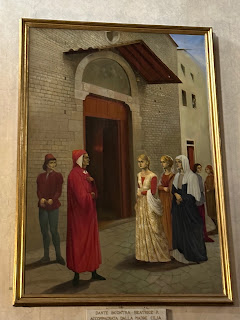

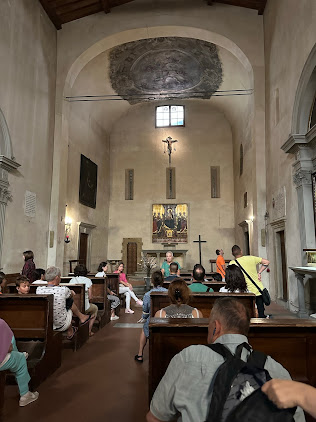



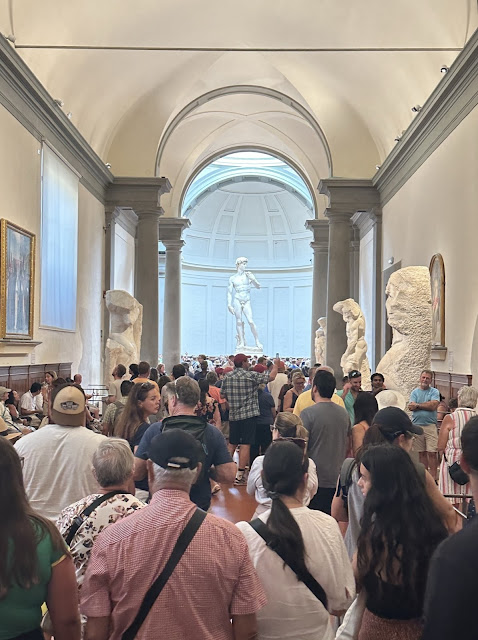


















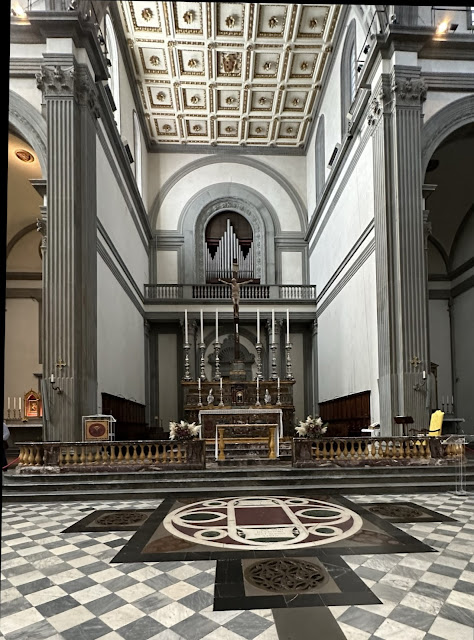


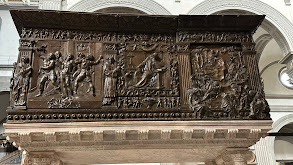











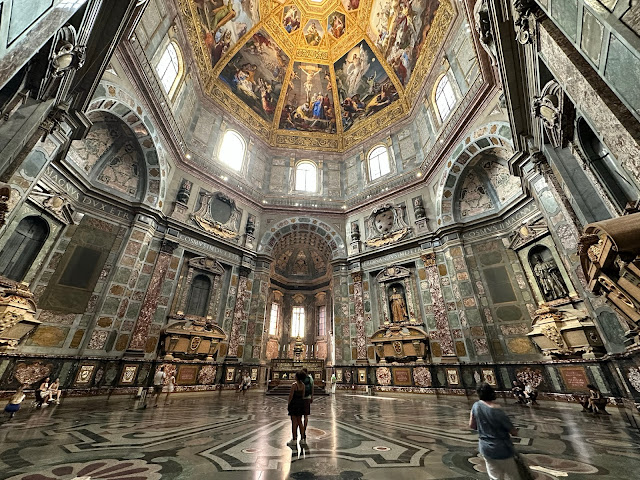










Comments
Post a Comment